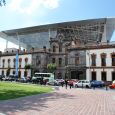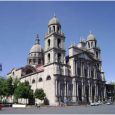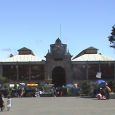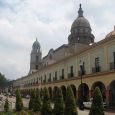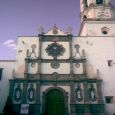Toluca
Advertisement
By plane
Toluca has its own international airport (IATA: TLC, ICAO: MMTO) serving many private jets, some U.S. airlines (e.g., Continental) and several Mexican airlines (e.g., Interjet).
International airport in Mexico City is another alternative.
By train
There is a passenger train from Mexico City to Michoacan which stops in Toluca. The equipment is old and the service is slow (sometimes taking twice as long as a bus).
By car
The highway between Mexico City and Toluca is one of the most modern in the country (and an expensive toll road).
By bus
Toluca has one of the largest bus terminals in the country. From Mexico City you can get several lines to Toluca at the western terminal called Observatorio (at the end of the east-west subway line). Flecha Roja has regular service to the northern terminal, Terminal Norte, as well. Buses for Toluca depart every few minutes. Some lines (e.g., Caminante) have on board movies. From the north side of Mexico City, there is a terminal at Cuatro Caminos also with buses to Toluca. Other buses run from the suburb of Naucalpan to Toluca.
By boat
There is no boat here: no lake, no river, no beach. It is too cold for outdoor swimming, but there is an Olympic sized pool on the southwest outskirts of town at the great athletic center.
Advertisement
Temple of La Merced
The Temple of La Merced is one of the most ancient convents still preserved and one of the most important founded by Spaniards. It is a beautiful building of a religious order called mercenarios, and it shows architectural styles from the 18th, 19th, and 20th centuries. Its principal facade has 3 naves and was constructed ithe 18th century on the remains of the old Temple of San Francisco. The interior of the temple exhibits neoclassical style with gold-leaf. It features oil paintings from the aforementioned times, such as the "Birth of San Pedro Nolasco", founder of the Mercenarios order. The temple became a hospice for orphans and beggars. Baroque construction style can be seen in the pilasters, niches and the order's shield. Inside, you can see paintings of Felipe Gutierrez, a Mexican painter who graduated from the San Carlos Academy. It is located in downtown Toluca on Jose Ma. Morelos street.
Los Portales
Los Portales represent the social and commercial life of the city. They are a composed of three sets of arches or portals that extend on the 3 sides of the city block that extends behind the main cathedral. Behind the sets of arches there is walking space that takes you around the stores that are contained within. The western arches follow the perimeter of what was the La Asunción Franciscan monastery. The eastern and southern arches were complted in 1836 by José María González Arratia.The original western arches were built by the Buenaventura Merlín. Each side consists of basket-handle arches, each with a balcony.
Cathedral of Toluca
The Cathedral of Toluca was begun in 1867 by José Francisco de Paula on land originally belongin to the Asunción de Toluca Franciscan monastery. The building was originally designed by Agustín Carrillo. However, in 1870, Ramon Rodriguez Arangoiti redesigned the cathedral, based on his experience with old Roman basilicas although the present-day building still contains a number of the elements of the original design such as the aisle that runs parallel to the façade serving as a narthex, allowing access to the central and two side naves. The straight central nave is lighted by round arched windows. The outside facade consists of two parts.
Santa Veracruz Temple
The Santa Veracruz Temple is the home of a famous image of "Our Lord of the Holy Cross" also known as a "Black Christ". This image was originally housed in the San Francisco Temple, but the increasing number of worshippers dictated the building of its own sanctuary. Construction began in 1753, but because of friction between the Franciscans and worshippers, it was not completed until 1797. Although the original plans included two towers, only one was built, containing two hexagonal bodies, pairs of columns and balconies with semicircular rails. Both bodies are topped with domes, each bearing a cross. The space that was reserved for the second tower instead has an ornate clock
Cosmovitral
The Cosmovitral is located in a stone and ironwork building in the center of Toluca built in 1910 by engineer Manuel Arratia in order to accommodate the "16 de Septiembre" market. It was constructed in Art Nouveau and Neoclassical style, with an area of 5,000 square meters. It is now a botanical garden with more than 400 species of plants from all over the world. It also features a series of stained glass windows that are considered the largest in the world. These windows were created and designed by a Mexican artist named Leopoldo Flores.
Plaza de los Martires
The center of the town is the Zócalo, also known as Plaza de los Mártires (Plaza of the Martyrs), which includes buildings such as the Palace of the State Government and the Justice Palace (Palacio de Justicia). The square is named after events that took place after the Battle of Tenango Hill during the Mexican War of Independence. Insurgent commander José Maria Oviedo was faced with the royalist army of Rosendo Porlier, who succeeded in driving the rebels northward to Toluca. Viceroy Venegas ordered reinforcments for Porlier's army and dispersed the insurgents, causing them to lose artillery and supplies.
Museum of Antropology and History
The Museo de Antropología e Historia (Museum of Antropology and History) has more than 1000 pieces on display, with an introductory room, five archeological rooms, seven ethnographic rooms and one historical room. Its theme is Mexico's place in the evolution of the hemisphere's history and geography, as well as the geopolitical and strategic importance of the State of Mexico. Some of the finest Aztec stone sculptures are on display, including an important image of the god Ehecatl.
Information not available
Information not available
Advertisement

